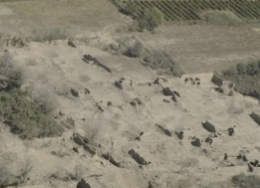Ed note: we are very pleased to have Christopher R. Albon join our roster of regular contributors to UN Dispatch. Christopher is a Ph.D. candidate at UC Davis researching human security, health diplomacy, and public health consequences of armed conflict. He also writes at ConflictHealth.
Earlier this month, former U.S. Army officer and current General David Petraeus biographer Paula Broadwell wrote a guest post on ForeignPolicy.com describing the rebuilding of the village of Tarok Kolache in Afghanistan’s Arghandab district. Within a day its publication, her piece would trigger a firestorm of criticism against the U.S. military; not about the village’s reconstruction, but rather its destruction. Why? Because the razing of Tarok Kolache was executed on the orders of a U.S. Army officer.
In the summer and fall of 2010, Taliban fighters drove out the civilian inhabitants of Tarok Kolache and turned the village into an insurgent stronghold, wiring it with improvised explosive devices. In the following months, the U.S. commander in charge of the area, Lieutenant Colonel David Flynn, sustained numerous casualties while attempting to clear the village. Faced with the prospect of more casualties and the fact the village was empty of civilians, Flynn decided the best course of action was to level the village with artillery and airstrikes. On October 6th, 49,200 pounds of rockets and bombs razed Tarok Kolache to the ground (photos of before and after). There were no civilian casualties. Afterwards, Flynn offered the residents of Tarok Kolache money to rebuild their village, and Broadwell even claimed the villagers liked how things had turned out.
The initial and best criticism of the village’s razing came from Joshua Foust, a fellow at the American Security Project. In a piece on TheAtlantic.com, he argued that the razing of Tarok Kolache was a short sighted decision, undermining the long-term U.S. attempts to win the hearts and minds of the Afghan people with ‘softer’ approaches. The pressure on local U.S. commanders, argued Foust, “to achieve ‘progress’ on an artificially short time frame has guided the U.S. military to make regrettable choices across much of Afghanistan”, the razing of Tarok Kolache being just one.
In response to Foust’s criticism, Flynn wrote a series of guest posts justifying his decision:
“Did I want to destroy the entire Taliban sanctuary and leave no structures for the people to return to? No. The choice, based upon my previous experience, was to lose or maim more of my soldiers or raze the structures and rebuild later. I had the greater context of the population in mind and felt with the relationships we had already made in the past three months, already solidified by the previous unit, that we could successfully resettle the population to this area.”
Regardless of who is correct (and I sit firmly in Foust’s camp), the greater take away is that, at the ground level, civilian populations will always bear the brunt of hardships during wartime. However well intentioned commanders, the brutality realities of armed conflict will often compel them to use force and violence for the sake of the safety of their soldiers or simple expediency. In other words, war is hell; even when attempting to win the hearts and minds of the population.
Photo: Paula Broadwell, via Wired, via Tom Ricks’ blog

